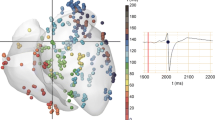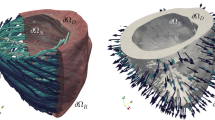Abstract
If a defibrillating stimulus current is applied to a one-dimensional fibre, and if the fibre has junction resistances joining the individual cells, what pattern of transmembrane voltages is induced by the stimulus, and what are the curretns that flow to produce the transmembrane voltages? These questions were considered in an earlier report; in this paper, two additional solution procedures are provided, one exact and one approximate, the latter relatively simple. Earlier work used a resistive model of the cells and junctions, together with a computer solution of 330 simultaneous equations for a 30-cell fibre. The present methods exploit the known solutions for the continuous (zero junctional resistance) fibre together with an analytic treatment of the junctions. With the present methods solution for currents and transmembrane potentials in the same 30-cell fibre requires a solution of only 29 equations (exact method) or the solution of none at all (the approximate method). The results show that, compared with previous results, the exact method provides almost identical transmembrane values; the approximate method gives values within 2 per cent.
Similar content being viewed by others
References
Clerc, L. (1976) Directional differences of impulse spread in trabecular muscle from mammalian heart.J. Physiol.,255, 335–346.
Hodgkin, A. L. andRushton, W. A. (1946) The electrical constants of a crustacean nerve fibre.Proc. R. Soc.,B133, 444–479.
Plonsey, R. andBarr, R. C. (1982) The four-electrode resistivity technique as applied to cardiac muscle.IEEE Trans.,BME-29, 541–546.
Plonsey, R. andBarr, R. C. (1986) Effect of microscopic and macroscopic discontinuities on the response of cardiac tissue to defibrillating (stimulating) currents.Med. & Biol. Eng. & Comput.,24, 130–136.
Weidmann, S. (1952) Electrical constants of Purkinje fibers.J. Physiol.,118, 348–360.
Weidmann, S. (1970) Electrical constants of trabecular muscle from mammalian heart.,210, 1041–1054.
Author information
Authors and Affiliations
Rights and permissions
About this article
Cite this article
Plonsey, R., Barr, R.C. Inclusion of junction elements in a linear cardiac model through secondary sources: Application to defibrillation. Med. Biol. Eng. Comput. 24, 137–144 (1986). https://doi.org/10.1007/BF02443926
Received:
Accepted:
Issue Date:
DOI: https://doi.org/10.1007/BF02443926




